
Pieter Brueghelthe Younger was a Flemish painter known for numerous copies after his father Pieter Bruegel the Elder's work, as well as original compositions and Bruegelian pastiches. The large output of his studio, which produced for the local and export market, contributed to the international spread of his father's imagery.

Rogier van der Weyden or Roger de la Pasture was an early Netherlandish painter whose surviving works consist mainly of religious triptychs, altarpieces, and commissioned single and diptych portraits. He was highly successful in his lifetime; his paintings were exported to Italy and Spain, and he received commissions from, amongst others, Philip the Good, Netherlandish nobility, and foreign princes. By the latter half of the 15th century, he had eclipsed Jan van Eyck in popularity. However his fame lasted only until the 17th century, and largely due to changing taste, he was almost totally forgotten by the mid-18th century. His reputation was slowly rebuilt during the following 200 years; today he is known, with Robert Campin and van Eyck, as the third of the three great Early Flemish artists, and widely as the most influential Northern painter of the 15th century.

Bernard van Orley, also called Barend or Barent van Orley, Bernaert van Orley or Barend van Brussel, was a versatile Flemish artist and representative of Dutch and Flemish Renaissance painting, who was equally active as a designer of tapestries and, at the end of his life, stained glass. Although he never visited Italy, he belongs to the group of Italianizing Flemish painters called the Romanists, who were influenced by Italian Renaissance painting, in his case especially by Raphael.

Gillis van Coninxloo was a Flemish painter of landscapes who played an important role in the development of Northern landscape art at the turn of the 17th century. He spent the last 20 years of his life abroad, first in Germany and later in the Dutch Republic.
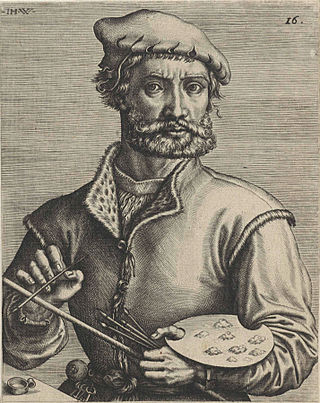
Pieter Coecke van Aelst or Pieter Coecke van Aelst the Elder was a Flemish painter, sculptor, architect, author and designer of woodcuts, goldsmith's work, stained glass and tapestries. His principal subjects were Christian religious themes. He worked in Antwerp and Brussels and was appointed court painter to Charles V, Holy Roman Emperor.

Hercules Pieterszoon Seghers or Segers was a Dutch painter and printmaker of the Dutch Golden Age. He has been called "the most inspired, experimental and original landscapist" of his period and an even more innovative printmaker.
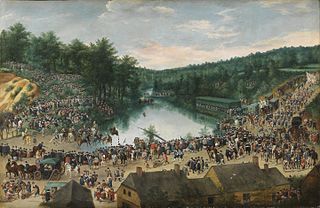
Denis van Alsloot or Denijs van Alsloot was a Flemish landscape and genre painter, draughtsman, and tapestry designer. He was employed as a court painter and worked for the local elite in Brussels. He is considered to be a member of the Sonian Forest school of landscape painters, which included landscape painters such as Jacques d'Arthois and Cornelis Huysmans. These painters working in Brussels had a preference for depicting scenes from the Sonian Forest near Brussels. Van Alsloot was also a specialist in depicting civil processions, local festivals and ceremonies.

Hendrik van der Borcht the Elder or Hendrick van der Borcht the Elder (1583 - 26 July 1651 was a Flemish-German engraver and painter of portraits, still lifes of antiquities, flowers and fruit and landscapes. He was also an eminent antiquarian. He was mainly active in Germany to which his family had emigrated for religious reasons.
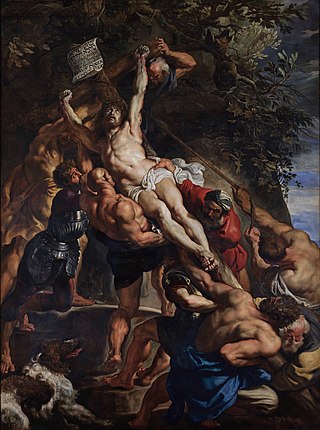
Flemish Baroque painting was a style of painting in the Southern Netherlands during Spanish control in the 16th and 17th centuries. The period roughly begins when the Dutch Republic was split from the Habsburg Spain regions to the south with the Spanish recapturing of Antwerp in 1585 and goes until about 1700, when Spanish Habsburg authority ended with the death of King Charles II. Antwerp, home to the prominent artists Peter Paul Rubens, Anthony van Dyck, and Jacob Jordaens, was the artistic nexus, while other notable cities include Brussels and Ghent.
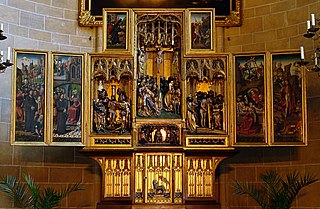
Jan Van Wavere was an influential Brabantine polychromer of late gothic Brabantine altarpieces, mainly produced in the Brabantine towns of Antwerp, Brussels and Mechelen. During the 15th–16th century, over 1000 altarpieces were traded and exported to many European countries. More than 300 complete examples of Brabantine altarpieces can still be found in museums and churches all over Europe, from the Baltic countries down to Spain.

Tobias Verhaecht (1561–1631) was a painter from Antwerp in the Duchy of Brabant who primarily painted landscapes. His style was indebted to the mannerist world landscape developed by artists like Joachim Patinir and Pieter Bruegel the Elder. He was the first teacher of Pieter Paul Rubens.

Jacques d'Arthois was a Flemish painter and tapestry designer who specialized in wooded landscapes with figures. He often depicted the woods around his native Brussels. Jacques d'Arthois was an influential painter and one of the few 17th century landscape painters from Brussels whose fame was remembered in the following centuries as his style was imitated and followed by many other landscape artists.

Jacques Fouquier, Jacques Fouquières or Jacob Focquier was a Flemish landscape painter. After training in Antwerp he worked in various places where he often obtained appointments as a painter to the court including that of the French kings. He earned great success and a very high reputation during his lifetime and was even referred to as the 'Flemish Titian'. Very few of his paintings have been preserved. His work was influential in his time and was widely circulated thanks to reproductions by various contemporary engravers.
Richard Brakenburgh or Brakenburg, was a Dutch Golden Age painter.

Jan Baptist van Heil or Jan Baptiste van Heil, was a Flemish Baroque painter of portraits and religious paintings.

Nicolaes de Bruyn was a Flemish engraver, who after training in Antwerp was active in the Dutch Republic.
Jan van Rijn or Jean de Reyn was born at Dunkirk about the year 1610, and went when he was young to Antwerp, where he became a student of van Dyck. Such was his progress under that master, that he was invited to accompany him to England, where he continued to assist him until the death of his illustrious instructor. He afterwards established himself in his native town, where he painted several admirable pictures for the churches, and was much employed as a portrait painter. His principal works for the churches at Dunkirk were the 'Death of the four Royal Martyrs,' for the church of St. Eloi; and the 'Baptism of Totila,' for the church of the English convent.

Pieter van Coninxloo was an Early Netherlandish painter first documented as active in Brussels from 1479. Little is known of his life apart from his appearance in records of 1479, 1503 and 1513, in the archives of Margaret of Austria when he is mentioned in relation to the commission of portraits. He came from a family of artists; at least six generations were painters. His brother was Jan van Coninxloo.
Jan Baptist Francken was supposed to be a painter from the Francken family and/or the son of Sebastian Vrancx, but is now considered to have been an error and to have never existed. The confusion was created by the many painters named Francken, some poor attributions, and a portrait by Anthony van Dyck of a certain Johannes Baptist Franck, aged 32, of whom nothing more is known. He is sometimes said to be the same as Hans Francken, another obscure member of the same family.
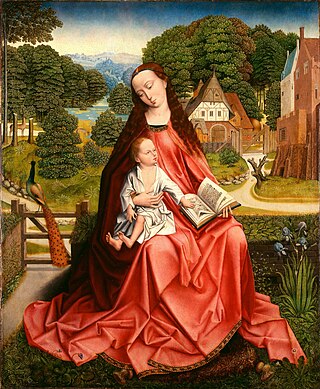
Aert van den Bossche or the Master of the Crispinus and Crispinianus-Legend was an Early Netherlandish painter of altarpieces, active in Brussels and Bruges in the late 15th century. There is still doubt as to whether he should be identified with the Master of the legend of St. Barbara or was only one of the artists active in a workshop responsible for the works of that master.

















